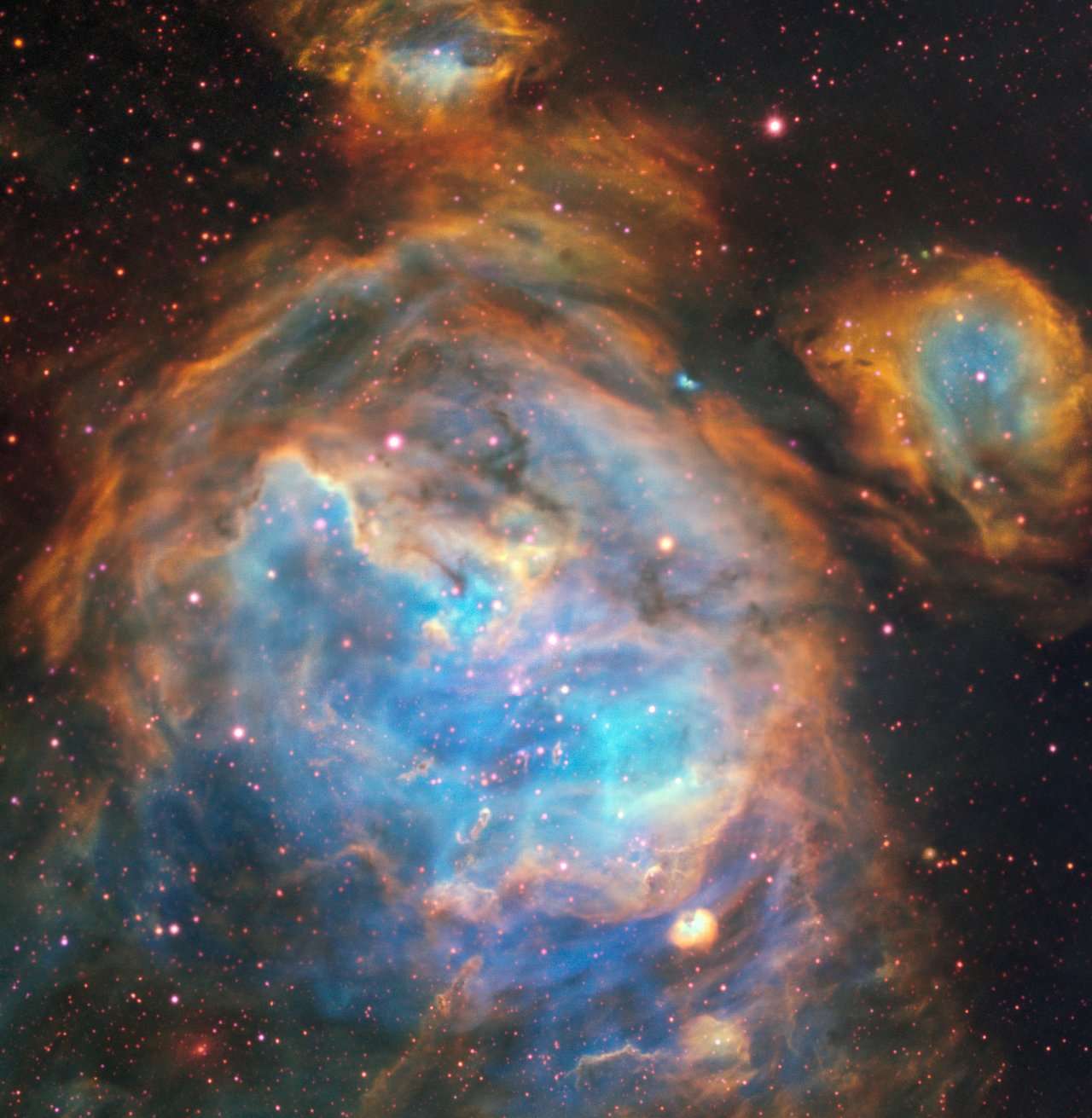
It's a face... It's a horse head... It's a nebula!
Finding familiar patterns in cosmic objects
- What are some of the most oddly-looking astronomical objects
- How astronomers use ESO telescopes and instruments to study them
A celestial bat-signalGotham’s most famous masked vigilante would immediately jump into action upon seeing this on the sky. This object, called CG4, is part of a star-forming region in our galaxy, about 1300 light-years away. This image was taken with the FORS1 instrument at ESO’s Very Large Telescope (VLT) in Chile. The area abounds with gas and dust, the raw material out of which stars are born, that clump in knots denser than their surroundings. Young blue stars (to the top-right of this image, but outside of the field of view) emit intense radiation that carves out the gas and dust within the nebula. But these dense knots withstand it, sculpting elongated tails that point away from the young stars, much like sand dunes form when the wind encounters an obstacle. CG in fact stands for “cometary globule”, as these long tails resemble those of comets. Credit: ESO |
|
|
An iconic mouseIf you tilt your head to the right you might recognise a famous mouse in this image. This star-forming nebula, called N180, is located in the Large Magellanic Cloud, a galaxy that orbits our home galaxy, the Milky Way. In this image taken with MUSE at ESO’s VLT, blue, yellow and red map the distribution of oxygen, hydrogen and sulphur, ionised by the radiation of the young stars at the centre of the nebula. Each single pixel in this image contains a full spectrum –– a “barcode” that astronomers use to decipher the physical properties of the objects they study. MUSE observations of star-forming regions allow astronomers to understand how young stars affect their surroundings, and to reconstruct the 3D shapes of these nebulae. Credit: ESO, A McLeod et al. |
Eyes in the skyThis object, called Mrk 739, bears a striking resemblance to the Cheshire Cat in Lewis Carroll’s Alice in Wonderland, including his mischievous grin. These are in fact two galaxies 400 million light-years away from us that are merging into each other. The gravitational dance between these two galaxies has distorted them into this friendly looking shape. Two supermassive black holes lurk at the centre of each “eye”. A team of astronomers recently observed these galaxies with MUSE at the VLT, measuring their motion as well as the age and chemical makeup of their stars. They found that one of the galaxies is much older than its neighbour, and that the merging process seems to be at an early stage. Credit: ESO/Tubin et al. |
|
|
It’s a bird! It’s a plane! It’s...… interacting galaxies! Like in the previous image, gravitational forces have reshaped these galaxies into a cosmic bird or Tinker Bell. The system, called ESO 593-IG 008, lies 650 million light-years away. This image combines data from NACO at the VLT and NASA/ESA’s Hubble Space Telescope. Astronomers originally thought that this object comprised just two spiral galaxies, but NACO revealed a third smaller one at the “head” of the bird. NACO (now decommissioned) observed at infrared wavelengths, which allowed astronomers to peer through dust. Moreover, it was equipped with an adaptive-optics system, which used a deformable mirror to counteract the atmospheric turbulence and deliver crisp images. Credit: ESO, NASA/ESA HST |
The largest ever pretzelThis image was obtained with ALMA, an array of radio telescopes in Chile of which ESO is a partner. It shows two baby stars being born out of pretzel-shaped streams of dust and gas. The two compact sources at the centre are dusty circumstellar disks around these young stars, each disk being as large as the asteroid belt in our Solar System. The surrounding pretzel loops, as massive as 80 Jupiters, feed material into the circumstellar disks. Binary stars are ubiquitous in the Universe, and these observations help astronomers understand how they form. Credit: ALMA (ESO/NAOJ/NRAO), Alves et al. |
Swimming in the cosmic ocean
Astronomers refer to the objects below as jellyfish galaxies, which are usually found in galaxy clusters. The space between galaxies in a cluster is filled with an extremely hot gas with temperatures of several tens of million degrees. When a spiral galaxy moves through a cluster, this hot gas exerts some pressure, pushing out that galaxy’s own gas, which trails behind forming intricate filaments.
As these galaxies lose their gas they slowly stop forming new stars. After some time they will mostly contain just old red stars, and their spiral arms –– where young stars are usually born –– will be significantly smeared out.
Biography Juan Carlos Muñoz Mateos
Juan Carlos Muñoz Mateos is Media Officer at ESO in Garching and editor of the ESO blog. He completed his PhD in astrophysics at Complutense University in Madrid (Spain). Previously he worked for several years at ESO in Chile, combining his research on galaxy evolution with duties at Paranal Observatory.








